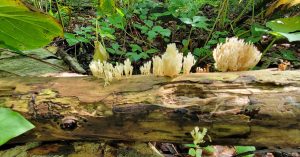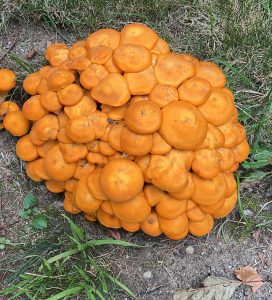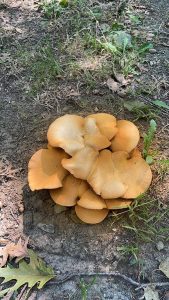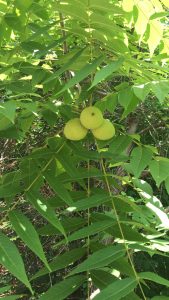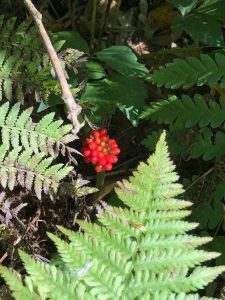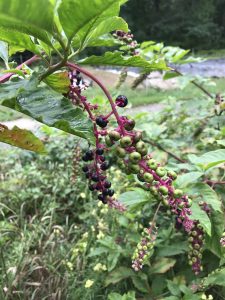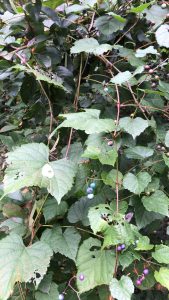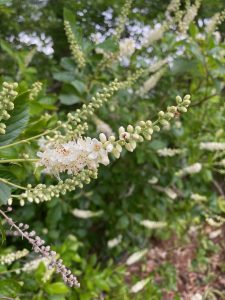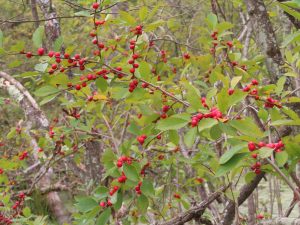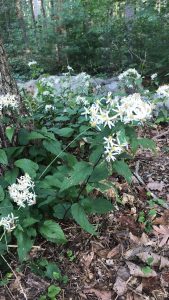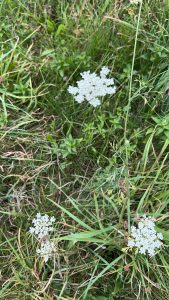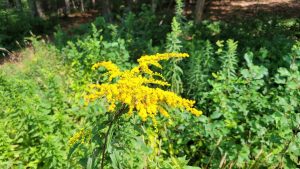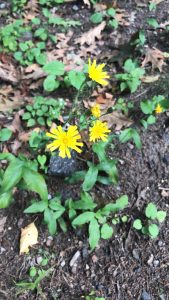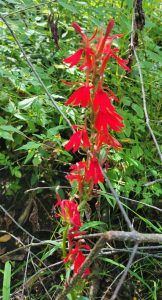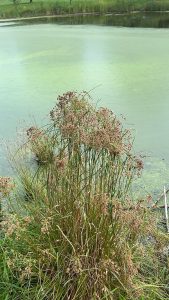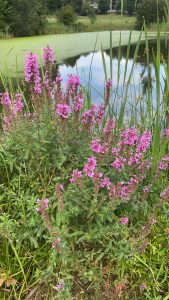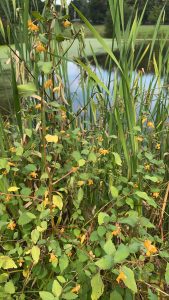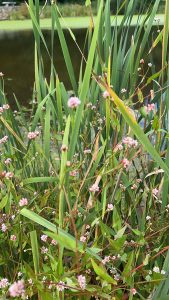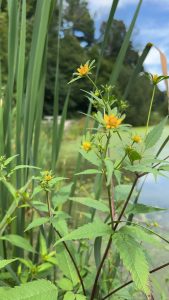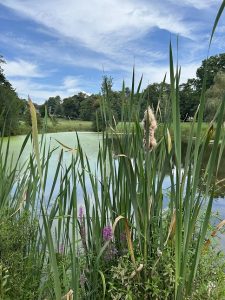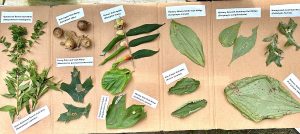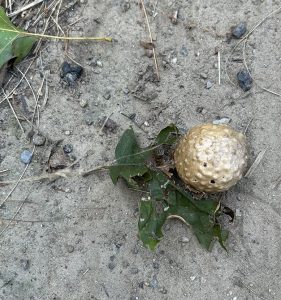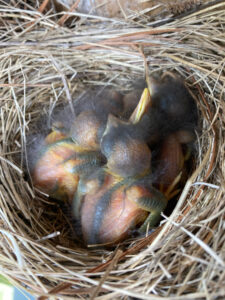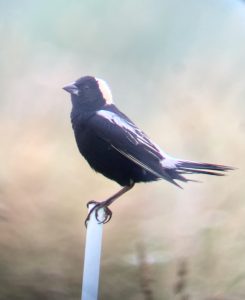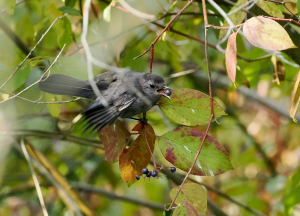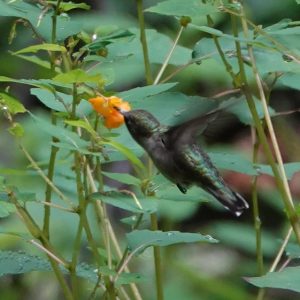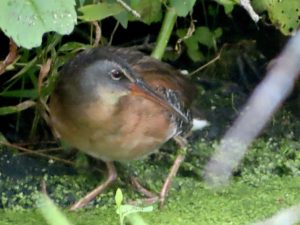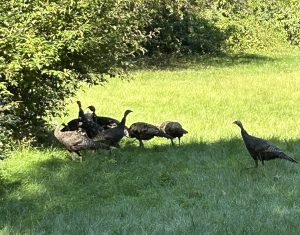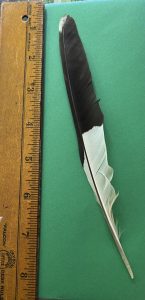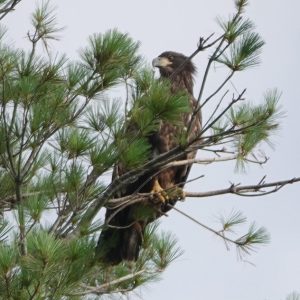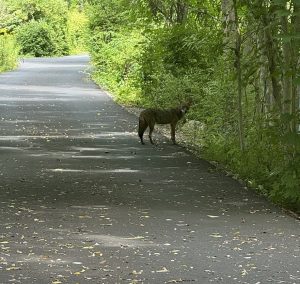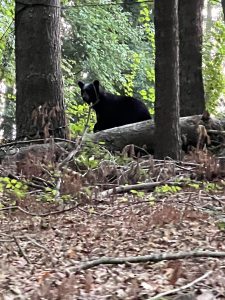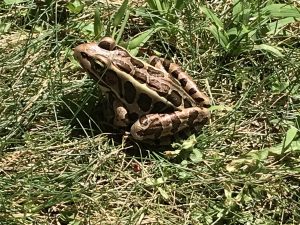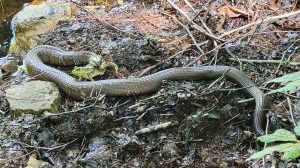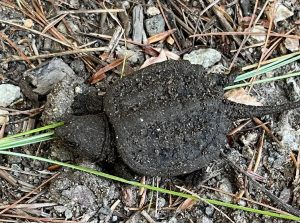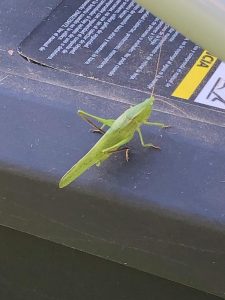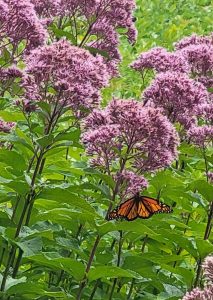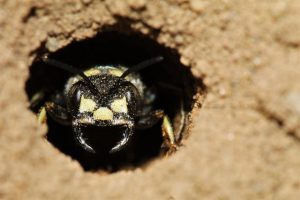Written by Gwyn Loud for the Lincoln Land Conservation Trust. She welcomes your sightings and questions at 781-259-8690 or gwynloud555@gmail.com
The autumnal equinox, giving us equal hours of darkness and daylight, will not occur until September 22 but already fall is in the air. Nights are cooler, leaves are hinting at changing color, and the sounds and scents of the new season are all around us. We have had a series of beautiful days for being outdoors, not too humid or hot. August brought us normal amounts of rain but so far we have had virtually none in September and the plants need it, as manifested in wilting leaves, and browning lawns. Brooks are either dry or low.
September is a month of bounteous wild food for birds and mammals in the form of plentiful seeds and berries. A lot of cones and acorns have already fallen, meaning this is a good mast year, and numerous animals, from wild turkeys to chipmunks will survive the winter better as a result. Blue jays, according to Mass. Audubon, “cache their acorns and collect a whopping 3,000 to 5,000 acorns in one autumn. And not just any acorns. These skilled jays can determine if the acorn is infested with pesky weevils—a process that still puzzles scientists—by simply picking one up in their beaks.” If you see what looks like green tennis balls hanging from a tree, you have found a black walnut tree. Winterberry, silky dogwood, Virginia creeper, pokeweed, and buckthorn are among the shrubs fruiting now, as are wild grapes (delicious for humans too!). Unfortunately, a very invasive plant in the grape family, porcelainberry, is also about to fruit, with beautiful small pink and light blue berries. It grows extremely fast, climbing up nearby trees and smothering other vegetation. Please watch for it on your property and see link below for more information.
Hawkweed and white wood asters are flowering along roadsides, and carpets of goldenrod lend beauty to fields, while being a wonderful source of pollen. Wild carrot and bedstraw are blooming in some hay fields and in swamps you may still find the spectacular cardinal flower. Recently, I walked around the Pierce Park Pond and found a nice variety of plants such as purple loosestrife, cattail, jewelweed, arrow-leaved tearthumb, woolgrass, and bur marigold bordering the pond. New England aster and closed gentian are among other flowering beauties this month. In the woods you might come across jack-in-the pulpit with its bright red berries, and you will certainly discover many fungi.
Galls are also much in evidence at this season. They are plant growths, usually triggered by an insect’s laying eggs on a leaf or stem. The plant then grows a little “home” in which the egg hatches, the larva grows, and eventually emerges as an adult. Oak apple galls are among the most common to see, looking like papery brown ping-pong balls, and if you see a tiny hole on the surface it means that the little wasp inside has developed and left the gall. A volunteer helping with phenology studies at Drumlin Farm this summer made a display of some of the many galls she found (see photo).
Avian nesting season is behind us and we have results from ten nest boxes on LLCT land (most were in Chapman Pasture) which were monitored once again by Patti Cable. She reported that 28 Eastern bluebirds and 12 tree swallows fledged, a number similar to 2023. Drumlin Farm has 38 boxes which are monitored and the fledglings there numbered 76 bluebirds, 30 tree swallows, 11 house wrens and 6 tufted titmice. It was the first time a titmouse had ever used one of the boxes. Bobolinks, long a treasured bird in Lincoln, did not have much breeding success this year. Mathias Bitter, an L-S student, monitored the bobolinks in Farm Meadow in an area set aside for them for many years. He found one nest and wrote, “The small groups of 2-4 bobolinks seen this year pale in comparison to the 50+ bobolinks that gathered at Farm Meadow just ten years ago, or the over 100 that were seen thirty years ago….It is important that natural areas like Farm Meadow are monitored and protected so that bobolinks can continue to thrive in Lincoln.” Drumlin Farm also has a field where they have nested in the past; this year only two nests were observed.
The fall bird migration started back in July for shorebirds and by mid-August for songbirds, most of whom just slip away without our noticing. Already flocks of grackles are passing by, flocks of young robins have appeared near my house, and a flock of forty-nine killdeer was counted in the crops fields at Drumlin Farm. Birders head to high points such as Mt. Wachusett to count migrating raptors but, when the winds are right, we can just look up and spot hawks such as broad-winged hawks winging their way south. Ruby-throated hummingbirds seem to have been more numerous this summer but before the end of the month they will have left on their journey to Central America. Several species of warblers have been seen recently, also on their way to warmer climes for the winter. In her latest Conservation Department news blast, Michele Grzenda quoted National Audubon, explaining, “Every year, billions of birds migrate north in the spring and south in the fall, the majority of them flying at night, navigating with the night sky. However, as they pass over big cities on their way, they can become disoriented by bright artificial lights and skyglow, often causing them to collide with buildings or windows. While lights can throw birds off their migration paths, bird fatalities are more directly caused by the amount of energy the birds waste flying around and calling out in confusion. The exhaustion can then leave them vulnerable to other urban threats.” Audubon’s Lights Out program is aimed at getting building owners and managers to turn off lights at night during migration.
Recent bird sightings of note include a Virginia rail with young along Valley Brook, two great egrets high overhead above Trapelo Road, a common loon calling from Flint’s Pond, flocks of wild turkeys with poults, and a hummingbird enjoying a garden sprinkler. Ron McAdow wrote that a juvenile bald eagle, “presumably the chick of the year from Fairhaven Bay, chose the top of a tall pine bordering Farrar Pond to sit and make extremely loud demands on its parents.” Examples of sightings from observers at Drumlin Farm include a yellow-bellied flycatcher, a least sandpiper, migrating wood ducks, and two Coopers hawks harassing seven crows. I found a spectacular black and white feather on a wooded trail and used a feather atlas on-line to identify it. The closest match was a pileated woodpecker, which made sense, as I see and hear them often in the area. An Old Concord Road resident described finding a dead robin which, over time, gradually disappeared down into the soil, with only feathers protruding. This was surely the work of a burying beetle, beetles which feed on carrion .
As for mammals, a young bear was photographed near Birches School on August 17 and it was probably the same one which had turned up near a bird feeder by a house on Page road a couple of days earlier. Observers see deer, sometimes bucks, but mostly does with older fawns. A deer’s coat may look patchy as they are changing to a thinker winter coat at this season. Carol Roede’s trail cam has picked up occasional sightings of bobcat, coyote opossum, muskrats, and beavers. Chipmunks galore dash across my lawn, feast on green tomatoes, and rabbits appear daily.
Many people have reported seeing beautiful pickerel frogs this summer, and I have watched small northern leopard frogs leap away in the grass. Gray treefrogs have continued to sing now and then, and Will Leona snapped a photo of a green frog meeting its demise in the jaws of a northern water snake. Some snapping turtles overwinter in their nests, but many also hatch at this season and head by instinct to the nearest water; an observer watched snapper hatchlings making their first journey on Old Concord Rd., fortunately far from traffic.
The insect chorus members, crickets, katydids, and grasshoppers, are in full voice at this season, providing a general background hum as well as more distinctive sounds such as that of the katydid. The katydid can be heard in the evening saying “katy-did” or “katy-did-did”, a sound the insect makes by rubbing the sharp edge of the right front wing rapidly against a file-like ridge on the left front wing.
Monarch butterflies seem to have been more plentiful in Lincoln this summer than last and now they are heading south to their wintering grounds in the mountains of Mexico, a journey they have never made before.
If you have been to the Lincoln Public Library recently you have seen yellow tape and warning signs around the small magnolia tree by the front steps. Yellow jackets are cruising around the tree. Why? It turns out the magnolia is afflicted with “magnolia scale”, soft-bodied insects which suck sap from the tree. Their sugary feces, called honeydew, are what attracts the wasps. The Library is having the tree treated professionally but it will take some time.
To see an amazing variety of dragonflies and various moths, butterflies, solitary and social wasps and bees, take an “armchair trip” to Chapman Pasture by watching Norman’s Levey’s beautiful and informative video which he made this summer (link below). Recently, Norman made another discovery, this time behind Smith School. A face was peering out of a hole in a patch of sandy soil and it turned out to be a smoky-winged beetle bandit wasp. These wasps are beneficial as they prey on emerald ash borers, beetles which are responsible for killing millions of ash trees across the country, including in Lincoln.
Looking skyward, two astronomical events of note will occur on September 18. The full moon that night, known by early Native American tribes as the Corn Moon, a.k.a. the Harvest Moon, will also be a supermoon, one of three in 2024. A supermoon is a full moon which occurs when it is closest to Earth in its elliptical orbit, meaning that the moon will appear larger and brighter than a regular full moon. There will also be a partial lunar eclipse that night, when part of the Moon will darken as it moves through Earth’s shadow.
Links
To read about National Audubon’s Light Out Program
To read about wasps on magnolia trees
To watch Carol Roede’s trail cam footage of a heron
To watch Norman Levey’s video of biodiversity in Chapman Pasture
To help you identify a bird feather
To watch Norman Levey’s video of the Smoky-winged Beetle Bandit Wasp


